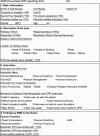Performance review of regional emergency medical service pre-arrival cardiopulmonary resuscitation with or without dispatcher instruction: a population-based observational study
- PMID: 29123877
- PMCID: PMC5674464
- DOI: 10.1002/ams2.273
Performance review of regional emergency medical service pre-arrival cardiopulmonary resuscitation with or without dispatcher instruction: a population-based observational study
Abstract
Background: To investigate variations in emergency medical service (EMS) pre-arrival cardiopulmonary resuscitation (CPR), including both bystander CPR without dispatch assistance and dispatch-assisted CPR (DACPR).
Methods: We carried out an observational study by implementing EMS pre-arrival CPR reports in three fire agencies. We included adult, non-traumatic, and non-EMS witnessed out-of-hospital cardiac arrests. This reporting system comprised the dispatch instruction process and bystander CPR quality based on evaluations by EMS crews who arrived on the scene. Bystander CPR was categorized as "ongoing CPR" if the bystander was performing CPR when the EMS reached the patient's side and "good-quality CPR" if the CPR was performed proficiently. We compared the frequencies of ongoing and good-quality CPR in the bystander CPR already started without dispatch assistance (CPR in progress) group and DACPR group.
Results: Of 688 out-of-hospital cardiac arrests, CPR was already started in 150 cases (CPR in progress group). Dispatcher CPR instruction was provided in 368 cases. Among these, callers started chest compressions in 162 cases (DACPR group). Ongoing CPR was performed in 220 cases and was more frequent in the DACPR group (128/162 [79.0%] versus 92/150 [61.3%], P < 0.001). Good-quality CPR was more frequent in the CPR in progress group, but the difference was not statistically significant (36/92 [39.1%] versus 42/128 [29.0%], P = 0.888).
Conclusions: Ongoing CPR and good-quality CPR were not frequent in EMS pre-arrival CPR. Detailed analysis of dispatch instructions and bystander CPR can contribute to improvement in EMS pre-arrival CPR.
Keywords: Cardiopulmonary arrest; emergency medical service; pre‐hospital care/medical control.
Figures


Similar articles
-
Dispatcher-assisted cardiopulmonary resuscitation and survival in cardiac arrest.Circulation. 2001 Nov 20;104(21):2513-6. doi: 10.1161/hc4601.099468. Circulation. 2001. PMID: 11714643
-
Dispatcher CPR Instructions Across the Age Continuum.Prehosp Disaster Med. 2018 Jun;33(3):342-345. doi: 10.1017/S1049023X18000377. Epub 2018 Apr 26. Prehosp Disaster Med. 2018. PMID: 29697042
-
Can a Software-Based Metronome Tool Enhance Compression Rate in a Realistic 911 Call Scenario Without Adversely Impacting Compression Depth for Dispatcher-Assisted CPR?Prehosp Disaster Med. 2018 Aug;33(4):399-405. doi: 10.1017/S1049023X18000602. Epub 2018 Jul 23. Prehosp Disaster Med. 2018. PMID: 30033904 Clinical Trial.
-
Outcomes of audio-instructed and video-instructed dispatcher-assisted cardiopulmonary resuscitation: a systematic review and meta-analysis.Ann Med. 2022 Dec;54(1):464-471. doi: 10.1080/07853890.2022.2032314. Ann Med. 2022. PMID: 35107406 Free PMC article.
-
Modified cardiopulmonary resuscitation (CPR) instruction protocols for emergency medical dispatchers: rationale and recommendations.Resuscitation. 2005 May;65(2):203-10. doi: 10.1016/j.resuscitation.2004.11.025. Resuscitation. 2005. PMID: 15866402 Review.
Cited by
-
Performance of dispatcher-assisted cardiopulmonary resuscitation integrating with mouth-and-nose covering instructions during the COVID-19 pandemic: a population-based retrospective study.BMC Emerg Med. 2025 Jul 26;25(1):134. doi: 10.1186/s12873-025-01296-8. BMC Emerg Med. 2025. PMID: 40713482 Free PMC article.
-
Dispatcher-Assisted Cardiopulmonary Resuscitation: Disparity between Urban and Rural Areas.Emerg Med Int. 2020 Jun 1;2020:9060472. doi: 10.1155/2020/9060472. eCollection 2020. Emerg Med Int. 2020. PMID: 32566308 Free PMC article.
-
Hand vs. leg-heel: Evaluating a viable second line approach for chest compressions to bridge the 'bystander's window'.Resusc Plus. 2025 Feb 3;22:100891. doi: 10.1016/j.resplu.2025.100891. eCollection 2025 Mar. Resusc Plus. 2025. PMID: 40026716 Free PMC article.
References
-
- Iwami T, Nichol G, Hiraide A, et al Continuous improvements in “chain of survival” increased survival after out‐of‐hospital cardiac arrests: a large‐scale population‐based study. Circulation 2009; 119: 728–34. - PubMed
-
- Wissenberg M, Lippert FK, Folke F, et al Association of national initiatives to improve cardiac arrest management with rates of bystander intervention and patient survival after out‐of‐hospital cardiac arrest. JAMA 2013; 310: 1377–84. - PubMed
-
- Song KJ, Shin SD, Park CB, et al Dispatcher‐assisted bystander cardiopulmonary resuscitation in a metropolitan city: a before‐after population‐based study. Resuscitation 2014; 85: 34–41. - PubMed
-
- Swor R, Khan I, Domeier R, et al CPR training and CPR performance: do CPR‐trained bystanders perform CPR? Acad. Emerg. Med. 2006; 13: 596–601. - PubMed
-
- Coons SJ, Guy MC. Performing bystander CPR for sudden cardiac arrest: behavioral intentions among the general adult population in Arizona. Resuscitation 2009; 80: 334–40. - PubMed
LinkOut - more resources
Full Text Sources
Other Literature Sources

